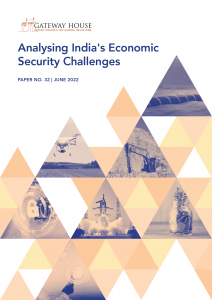In the decade preceding the global pandemic, India’s economy experienced a favourable global climate for growth. This period saw two key developments: low global commodity prices and double the inflow of foreign direct investment into India to over $50 billion in 2019. Since the pandemic, and now the war in Ukraine, vulnerabilities in the interconnected global economic system have created insecurity in the flow of goods, people and ideas and increasingly made governments vary of external threats to “economic security”.
For a developing country like India, economic security refers to its ability to pursue its own developmental goals, independent of threats, internal or external, or coercion. Economic security is a key pillar of national security.
The Indian government has pursued this in several ways, including by seeking partners to aid India’s economic growth – the U.S., Japan, the E.U. and China. However, the past two years have thrown up several new challenges, complicating this process. The Covid-19 pandemic has hit global supply chains and caused severe economic hardship. India has a military confrontation on its borders with China, severely complicating that relationship. Among India’s immediate neighbours, Pakistan and Sri Lanka offer stark examples of poor economic policies leading to internal turmoil – a reminder of the need for strong and uninterrupted growth in a country with a poverty rate of 10% and a highly aspirational population. Finally, the conflict in Ukraine is leading to a global commodity price shock – for food, fertilisers, energy and raw materials.
Covid and Ukraine have shown the importance of diversification – be it the supply chains for the manufacturing sector, energy imports, raw material, supplies, technology or for capital. However, this comes at a cost. For instance, investing in an oil field in South America can help reduce India’s vulnerability to high oil prices, but it also requires capital and other resources like management bandwidth and technical capabilities to do so. Investing in natural gas and fertiliser manufacturing is more expensive than buying the fertiliser outright from the global market – and there are times when markets fail.
The past two years have resulted in multiple such failures and consequent economic pain. This series of papers examines six important dimensions of economic security in India, the challenges they present, and the mitigation measures needed to set them right.
You can download the PDF version of this report here.
This publication is supported by The New Energy and Industrial Technology Development Organization (NEDO) through their Representative Office in New Delhi, India.
The views and opinions expressed in this paper are solely those of the authors. The view expressed in the paper do not necessarily reflect those of NEDO.
For interview requests or for permission to republish, please contact outreach@gatewayhouse.in.
© Copyright 2022 Gateway House: Indian Council on Global Relations. All rights reserved. Any unauthorized copying or reproduction is strictly prohibited.



